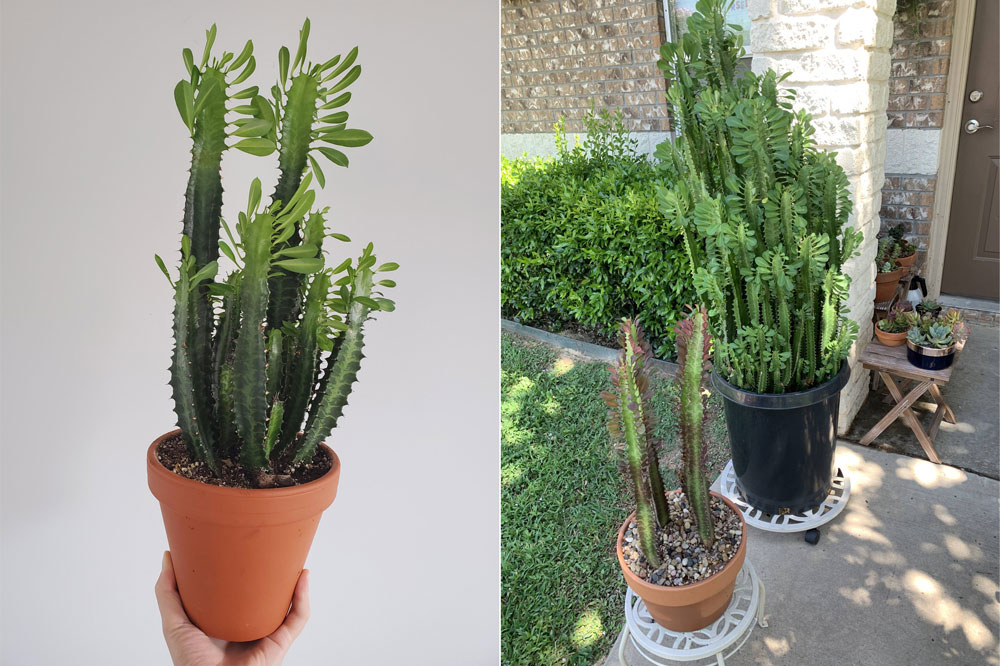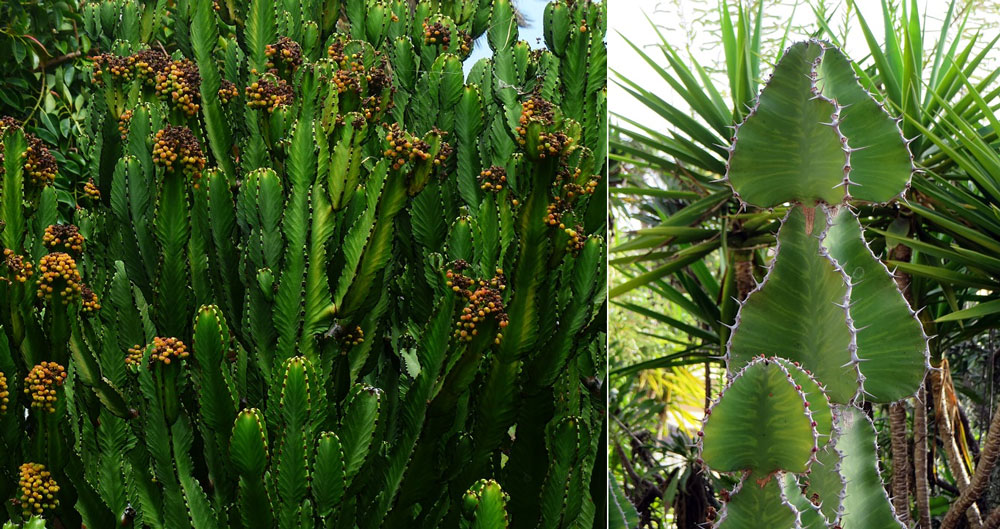Euphorbia Trigona: How to Care For the African Milk Tree Plant
Do you fancy adopting a tall, bushy, and drought-resistant succulent with a rare crown of thorns?
Read on to find if the Euphorbia Trigona succulent is charming enough and seemingly appropriate for your extra gardening space. In this guide, you’ll have a hands-on background of all it takes to grow and take decent care of the African Milk Tree Cactus.
Euphorbia Trigona, The African Milk Tree
Let’s face it—taking care of houseplants can sometimes be an overwhelming experience, more precisely for starters. But luckily, the Euphorbia Trigona (scientific name) is an extremely impressive houseplant with less nurturing demands than most other succulents.
It’s natively from West Africa and traces its genetic roots from the Euphorbiaceae family. It’s also dubbed “the African Cactus” due to its place of origin. Some natives in Thailand strongly believe that the crown of thorns which grows this plant foresees the fortune of its keeper.
Why Is It Called ” The African Milk Tree”?
It’s crucial to note that all the plants in the Euphorbiaceae family ooze out a poisonous white sap when squeezed or cut, hence the name. And consequently, you want to keep it out of reach of your kids or pets.
You’ll equally need to be watchful when dealing with the red variety (Royal Red). Whenever you run your routine pruning, use protective gear to prevent your eyes and skin from contact with the toxic sap.
You’ll also need to observe these safety measures when repotting your Euphorbia Trigona plant. The milky sap is proven to cause irritant signs on the skin and eyes, according to a report from the Center of Biotechnology Information in the US National Library of Medicine.
Is It An Actual Tree?
You could be wondering, probably. Sadly, the bland notion that this plant is a tree is scarcely credible and so we need to debunk the uncertain buzz. Well, the fact is, this plant would surprisingly grow up to 9 feet tall and resemble the shape of a large branched candlestick — even more so if you let it have an outdoor experience because that’s exactly where it belongs. And that’s more reason why it’s casually classified as a tree since it has a few traits that resemble those of a real tree.
Hence, it also goes with other names such as the Candelabra cactus or Euphorbia cactus. If you want to take the edge off its growth rate, you can pluck off a few stems and replant them in new containers. We’ll dive deep on how to replant the stems right in the propagation section, just so you know.
Perhaps you’re also curious to know if the Euphoria trigona is a cactus. Even though the African milk tree resembles a cactus, it’s actually not one. It’s also neither a tree nor a thick bush plant. But it’s generally grouped as a succulent plant in spite of the fact that it emerges a few leaves during its maturity stages. These leaves, however, don’t survive for long.
How Big Does Euphoria Trigona Grow?
From over 2 decades ago, there have been major efforts by hybridizers to improve the newer breeds of this plant. Using a few solid tips, you can, now more than ever, take care of your African Cactus with little to zero trouble and make it bloom throughout the year like it’s on cruise control.
This plant loves to grow outdoors under USDA hardiness zones 9-11. If you expose it to bright light and warm temperatures, it can reach about 3 to 6 feet tall, thereabout.
It develops three-fold stalks with the formidable potential to grow to about 6-8 feet in height. As it grows older, the stalks become thicker and form branches resembling those of cactus plants.
You’ll also see glaring-green leaves growing alongside the edges of the stalk. This feature indicates that your plant’s wellbeing is in good shape.The African milk tree retains a rustic and elegant look even when you ditch it for a few weeks, but will be more radiant if you take care of it routinely.
Euphorbia Trigona Caring Tips
Soil & Watering Needs
Considering where it natively comes from, this perennial plant can go a little frugal when it comes to watering. But since it’s a succulent and not a cacti plant, it can’t withstand lengthy drought periods. So you need to keep the soil moderately moist. During spring and summer, water it evenly to inhibit its growth prospects. But make sure it’s no more than 1 inch every 6 days or so—mostly during summer.
Watering the African milk tree regularly when the temperatures are high, helps maintain its texture and appearance. Always check if the first two inches of the soil is completely dry before watering your plant again. It’s needless to say that you need a growing medium with enough drainage holes to keep your roots from rotting. If the plant begins to wilt, check the soil to figure out the moisture level.
Watering your Euphorbia plant preferably in the evening could be so effective since this is when the moisture uptake level is at its peak. Most succulents, including the Euphorbia Trigona, develop well in well-draining soil. Another requirement you want to observe is using sandy potting soil. I prepare my own succulent soil since it’s cheaper than purchasing the commercial cacti potting mix. Apart from amending your potting mix with coarse sand, adding perlite or pumice also works great to help the soil absorb moisture much faster.
Grooming & Maintenance
The African milk tree grows horizontally and branches into three strapping stalks, so it doesn’t strictly need any grooming to look appealing.
Instead, you practically have the autonomy to choose whether to prune your plant or not. But if there are significant blemishes on a branch, it would be prudent to chop it off—to prevent the damage from worsening. Use a sharp and sterilized knife to keep your plant from catching bacterial infections. Dissect the ruined branch 2 inches right on the lower part of the affected part. This exercise also requires you to use protective gear—to avoid contact with the poisonous sap from the milk tree.
Fertilizer
The African milk tree can persistently grow per its typical yield rate in sandy-based soil since its texture helps balance the moisture levels. Even so, your plant needs essential macronutrients to bloom and grow at a cracking pace.
Use soluble fertilizer that’s recommended for succulent plants once a month every summer and spring. Bring down the number of watering intervals when it’s fall or winter and don’t use fertilizer on your plant during these two seasons.
Dealing With Common Pests & Diseases
Even when you grow it under the most suitable conditions, the African milk tree is still prone to a few pests diseases.
But on the bright side of things, it’s resistant to many problems that are common with other succulents. In most instances, this plant suffers a massive mealybugs infestation. Use alcohol to wipe off whitish warts which appear in the leaves, or even better, purchase neem oil and spray it on the affected areas.
If you notice a few dents on the stems emerging mostly during spring or summer, that could highly likely be a fungal infection that’s widely known as the Cork disease. You also need to watch out for other strains of fungi infections that hit your plant mostly when you overwater or grow it in ultrarich soil.
To keep the roots safe from rotting, you need to keep tabs with these handy tips:
- Water your plant a little less during winter since it needs some resting period. Inversely, you don’t want to underwater it during spring and summer.
- Inspect your Euphorbia roots every 2 or 3 months for any pests or diseases.
- Use a disinfectant on the pot and use new soil once you spot an infestation or symptoms of a disease—to suppress the chances of your plant getting re-infected.
- Add horticultural charcoal to improve the drainage process especially if the roots begin to exhibit early signs of rotting.
How to Propagate African Milk Trees
Propagating any type of succulent isn’t a hard thing to do.
For best results, propagate this plant either during spring or summer when the temperatures are above 70°F.
- Don’t miss to use protective gear( gloves and goggles) during this exercise to avoid any irritation on your skin or eyes.
- Sterilize your knife and use it to cut a healthy stem from the parent plant; one that has few to zero dents and is taller than 5 inches.
- Use water to stop the white sap from oozing.
- Leave the stem to harden for about 7 days or slightly more, by placing it somewhere with dry air circulation. This helps the stem form a callus that prevents it from rotting.
- Get rid of the tiny leaves at the bottom parts of the cutting. Plant it at least 1-inch deep in a pot whose diameter is about 4 or 5 inches.
- Use a growing medium that drains well. Perlite, cactus potting mix, or a proportionate composition of peat moss and sand would help your plant grow thickly and bountifully. You can add coarse gravel right above the topsoil to make the plant have a firm base as it grows older and taller.
- Place the newly propagated cutting under a warm environment but don’t expose it to direct sunlight. Make sure the temperatures are anywhere between 65 and 75 °F. Typically, it should only take about 2-3 months for your plant to sprout a few nutrient-absorbing roots.
- When maturity hits, this would be the best time for transplanting your plant from the old medium to a pot that’s ideally 6 inches big.
- Use the potting soil which we’ve suggested earlier in this guide and the let the plant to mutate to its new environment a little bit before watering it.
Safety Tip
The sticky white sap that oozes from the stems of the Euphorbia Trigona plant carries significant toxicity levels. You need to protect your asking and eyes from contact. It’s also highly recommended to place the medium far from kids and pets.


Why is my African Milk tree turning red? I bought it 4 months ago and it was all green….now the leaves are turning red! Not very attractive…..The plant is about 7 inches tall with four healthy “arms” growing out of the main stem. Gorgeous plant. But why turning red?
Thanks for any help! Your writeups are excellent help!
I guess it can be greener if you put it in a shaddier place.. mine was reddish then turned greenish in my apartment and I moved it to the corner with much sunlight it turns red again :) and I think the leaves can last longer of the soil is moist. I watered mine everyday and it is lush and healthy (but I live in a very hot weather, all year long about 38°C feels like 40-45°C)